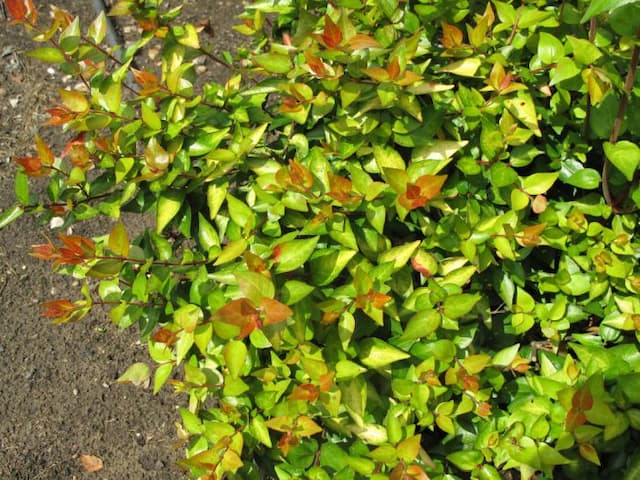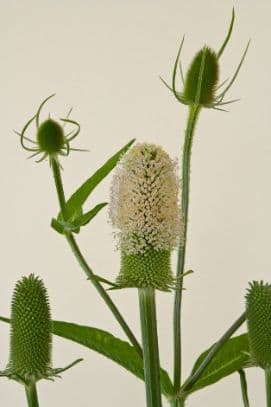Korean Weigela Weigela coraeensis 'Alba'

ABOUT
Weigela is a deciduous shrub known for its appealing foliage and captivating flowers. The 'Alba' variety specifically features leaves that are a lush green hue, providing a vibrant backdrop for the blossoms it produces. The foliage may sometimes display a subtle variegation that adds visual interest and texture to the garden. Spring into early summer is when this Weigela truly shines, adorned with a profusion of funnel-shaped flowers. The ‘Alba’ cultivar is distinctive for its white flowers, which stand out against the greenery. These blossoms are particularly attractive to pollinators such as hummingbirds and bees, adding not only beauty but also ecological value to its surroundings. As the seasons change, the green leaves of Weigela 'Alba' can transform into subtle shades of red and yellow, providing a delightful display of autumnal color. The plant's overall form tends to be gracefully arching, with a flowing, sometimes sprawling habit that creates movement within the landscape. The contrast between the white flowers and the green foliage makes this Weigela a charming addition with its serene and classic color palette.
About this plant
 Names
NamesFamily
Caprifoliaceae
Synonyms
White Weigela, White Korean Weigela
Common names
Weigela coraeensis 'Alba'.
 Toxicity
ToxicityTo humans
Weigela is generally considered non-toxic to humans. There is no widespread documentation of toxicity or poisoning symptoms associated with ingestion of Weigela plants. However, it is always advisable to avoid ingesting plants that are not commonly recognized as edible, as individual allergic reactions or stomach upset can occur.
To pets
Weigela is not commonly listed as a toxic plant for pets such as dogs and cats. It is not known to cause poisoning in pets, and there are no specific symptoms related to Weigela ingestion. However, as with humans, pets may experience individual reactions or gastrointestinal upset if they consume non-food plants. Always exercise caution and prevent pets from eating ornamental plants.
 Characteristics
CharacteristicsLife cycle
Perennials
Foliage type
Deciduous
Color of leaves
Green
Flower color
White
Height
4-6 feet (1.2-1.8 meters)
Spread
4-6 feet (1.2-1.8 meters)
Plant type
Shrub
Hardiness zones
5
Native area
Korea
Benefits
 General Benefits
General Benefits- Aesthetic Appeal: Weigela florida 'Alba', commonly known as white weigela, produces showy white flowers that can enhance the visual appeal of gardens and landscapes.
- Attracts Pollinators: The flowers of the white weigela are attractive to bees, butterflies, and other pollinating insects, promoting biodiversity.
- Easy to Grow: White weigela is known for being easy to care for, making it suitable for gardeners of all skill levels.
- Durable: It is a hardy plant that can withstand various climates, making it a resilient choice for many gardens.
- Seasonal Interest: With blooms in spring and sometimes a second flush in late summer, white weigela offers multi-seasonal interest.
- Low Maintenance: Once established, white weigela requires minimal maintenance, aside from occasional pruning to maintain shape and encourage flowering.
- Wildlife Habitat: The dense foliage provides shelter and nesting sites for birds and other wildlife.
- Versatile Landscaping: It can be used in a variety of landscape designs, including borders, hedges, and as focal points in gardens.
 Medical Properties
Medical PropertiesThis plant is not used for medical purposes.
 Air-purifying Qualities
Air-purifying QualitiesThis plant is not specifically known for air purifying qualities.
 Other Uses
Other Uses- Photography Backdrop: The white blooms of Weigela can serve as a natural and attractive backdrop for garden photography or portrait sessions.
- Educational Tool: This plant can be used in botanical studies for students learning about different plant species and their growth habits.
- Sound Barrier: Planted in a dense hedge, Weigela can help reduce noise pollution in suburban or urban gardens.
- Privacy Screen: When planted in a row along a property boundary, Weigela can provide a visual screen and enhance privacy.
- Windbreak: This shrub can be used to break the force of wind in exposed or coastal areas, protecting more sensitive plants.
- Winter Interest: Even after the leaves fall, the intricate branching pattern of Weigela provides visual interest in a winter garden.
- Artistic Inspiration: The flowers and form of Weigela can be a subject for drawing, painting, and other forms of artistic expression.
- Culinary Garnish: Although not commonly known for culinary use, the flowers could potentially be used as a decorative garnish for their aesthetic appeal.
- Thematic Gardening: Weigela can be used in a 'white garden' theme where all plants feature white blooms or foliage for a moonlit garden effect.
- Beekeeping Support: Weigela flowers can provide a source of nectar for bees, helping support local beekeeping activities.
Interesting Facts
 Feng Shui
Feng ShuiThe Weigela is not used in Feng Shui practice.
 Zodiac Sign Compitability
Zodiac Sign CompitabilityThe Weigela is not used in astrology practice.
 Plant Symbolism
Plant Symbolism- Optimism and Hope: The Weigela plant often blooms with lush and abundant flowers, which has been associated with positivity and the hope for good things to come.
- Romantic Love: Weigela's charming flowers can symbolize the bloom of romance or the celebration of love, often planted in gardens as a tribute to these feelings.
- New Beginnings: The emergence of its flowers in spring is symbolic of new beginnings, making it a suitable plant for gifting during times of change or growth.
 Water
WaterKorean Weigela should be watered deeply, approximately once a week, depending on the climate and soil conditions. Aim to provide about 1 inch of water, which translates to about 0.623 gallons for each square foot of soil area, ensuring that the water penetrates deeply into the root zone. During hotter, dry spells, watering frequency should increase to every few days. It's important to reduce watering in the fall to prepare the plant for winter. Always check the soil moisture before watering to avoid overwatering, as this can lead to root rot.
 Light
LightKorean Weigela thrives best in full sun to partial shade conditions. The ideal spot for this plant is where it can receive at least 6 hours of direct sunlight each day, though it can tolerate some afternoon shade, especially in hotter climates. Avoid deeply shaded areas, as too little light can reduce flowering and can cause the plant to become leggy.
 Temperature
TemperatureKorean Weigela is hardy and can withstand a temperature range from the United States Department of Agriculture (USDA) plant hardiness zones 4 to 8, which equates to a minimum temperature of around -30°F to -20°F. For optimal growth, maintaining a temperature range between 50°F and 75°F is ideal. Sudden temperature fluctuations should be avoided to prevent stress on the plant.
 Pruning
PruningPruning Korean Weigela is done to maintain its shape, encourage bushier growth, and improve its flowering. The best time for pruning is immediately after its spring flowering has concluded. Prune by cutting back about one-third of the oldest stems to the ground to stimulate new growth and removal of any dead or damaged wood. This plant blooms on the previous year's growth, so prune sparingly and not more than once a year to avoid cutting off next year's flower buds.
 Cleaning
CleaningAs needed
 Soil
SoilThe White Weigela flourishes best in well-draining soil enriched with organic matter, such as compost or peat moss, to encourage healthy growth. A slightly acidic to neutral pH range, ideally between 5.5 and 7.5, is suitable for this shrub.
 Repotting
RepottingWhite Weigela generally does not require frequent repotting and can be repotted every few years or when you observe that the plant has outgrown its current container.
 Humidity & Misting
Humidity & MistingThe White Weigela prefers average humidity levels and is fairly adaptable to the typical range found in outdoor garden environments, without the need for special humidity adjustments.
 Suitable locations
Suitable locationsIndoor
Ensure bright indirect light, well-draining soil, and room to grow.
Outdoor
Plant in sun or part shade, provide mulch, and space well.
Hardiness zone
5-8 USDA
 Life cycle
Life cycleWeigela coraeensis 'Alba', commonly known as the white Weigela, begins its life cycle as a dormant seed that germinates in spring when soil temperatures and moisture conditions are suitable. The seedling stage is characterized by the emergence of the cotyledons and the first true leaves, establishing the plant before it enters a rapid vegetative growth phase where stems, leaves, and the root system develop robustly. Once mature, the white Weigela enters its flowering stage, typically in late spring to early summer, producing clusters of trumpet-shaped white flowers that are attractive to pollinators like bees and butterflies. After pollination, flowers develop into small capsules containing seeds, completing the reproductive stage. The plant may enter a period of dormancy in the fall, with leaves changing color and falling off, as it conserves energy for the next growing season. With proper care, Weigela coraeensis 'Alba' can continue its life cycle for many years, growing into a larger shrub and producing flowers annually.
 Propogation
PropogationPropogation time
Spring-Early Summer
Propogation: Weigela coraeensis 'Alba', commonly known as White Weigela, is most effectively propagated by softwood cuttings during late spring to early summer, when the plant's new growth is still pliable but not too tender. To do this, a gardener should select a healthy stem with several sets of leaves and snip it to a length of about 4 to 6 inches (approximately 10 to 15 centimeters). The lower leaves are then removed, and the cut end can be dipped in a rooting hormone to encourage root development. This cutting is then placed in a well-draining potting mix and kept in a humid environment with indirect sunlight. Rooting typically takes a few weeks, after which the new Weigela can be transplanted to a more permanent location.








